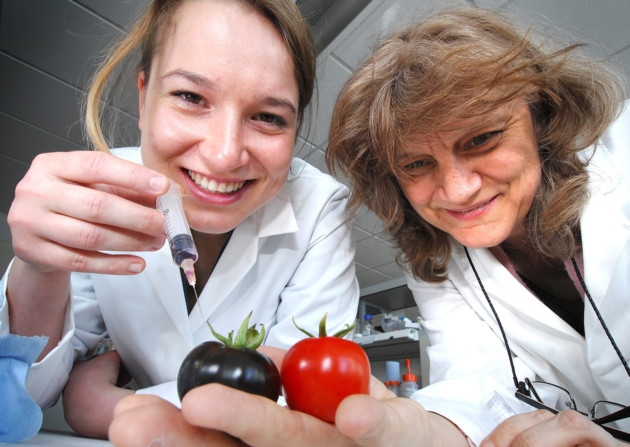Meet the purple tomatoes which produce as much Revervesterol in a single fruit as 50 bottles of wine, and as much anti-breast cancer chemical as 2.5Kg of Tofu!
 The John Innes Centre in Norwich (East England) have engineered these tomato plants to produce larger amounts of these health-related compounds. With funding from the Biotechnology and Biological Sciences Research Council (BBSRC) and as part of the European ATHENA project, these GMO tomato plants could be hugely helpful in industrial scaling up of production for these compounds.
The John Innes Centre in Norwich (East England) have engineered these tomato plants to produce larger amounts of these health-related compounds. With funding from the Biotechnology and Biological Sciences Research Council (BBSRC) and as part of the European ATHENA project, these GMO tomato plants could be hugely helpful in industrial scaling up of production for these compounds.
This project was started of by the extraction of the AtMYB12 protein from the common UK garden plant Arabidopsis thaliana, which is also a common model from the mustard family (Brassicaceae) for research in plant biology.
The research team at Cathie Martin’s lab found that the AtMYB12 protein could be used to activate biosynthesis pathways of Reversterol in tomatoes, as well as other phenylpropanoids and flavanoids of Biotech interest.

Reversterol is that famous beneficial compound every one mentions when defending a second glass of red wine. However, whilst it’s health benefits may be slightly exaggerated, it does have some positive effects in cardiovascular disease (though the results are still inconclusive).
The other compound they have engineered the plants to produce is Genistein, commonly found in soybeans, which has been suggested to play a role in prevention of steroid-hormone related cancers (e.g. breast cancer).

Purification of target compounds could be done from the tomato juice, of which a huge volume can be produced for a relatively small area of arable land. Indeed, Yang Zhang (one of the lab researchers) went on to suggest this green method of biomanufacuring biologicals could be developed to also produce terpenoids and alkaloids (which are the key groups of medical compounds found in plants):
Medicinal plants with high value are often difficult to grow and manage, and need very long cultivation times to produce the desired compounds.”
This tomato platform could therefore be a fantastic Green (and sometimes purple) platform to produce medical compounds in large quantities and relatively cheaply.





